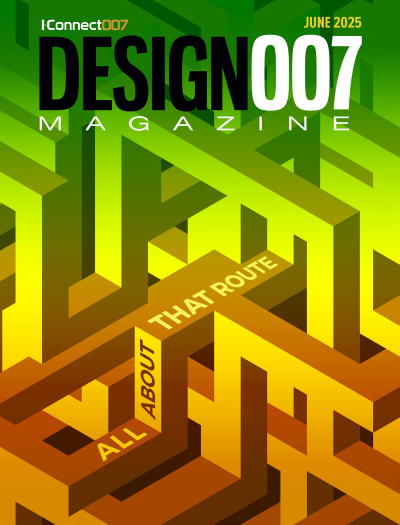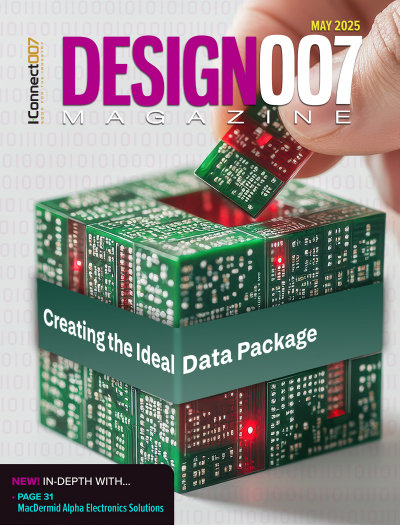-

- News
- Books
Featured Books
- design007 Magazine
Latest Issues
Current Issue
All About That Route
Most designers favor manual routing, but today's interactive autorouters may be changing designers' minds by allowing users more direct control. In this issue, our expert contributors discuss a variety of manual and autorouting strategies.

Creating the Ideal Data Package
Why is it so difficult to create the ideal data package? Many of these simple errors can be alleviated by paying attention to detail—and knowing what issues to look out for. So, this month, our experts weigh in on the best practices for creating the ideal design data package for your design.

Designing Through the Noise
Our experts discuss the constantly evolving world of RF design, including the many tradeoffs, material considerations, and design tips and techniques that designers and design engineers need to know to succeed in this high-frequency realm.
- Articles
- Columns
- Links
- Media kit
||| MENU - design007 Magazine
IPC Design Competition Wrap-up
April 6, 2023 | I-Connect007 Editorial TeamEstimated reading time: 2 minutes
The IPC Design Competition took place during IPC APEX EXPO 2023, with five finalists competing—a far cry from the original 49 entries last fall. After the competition was over, we spoke with Kris Moyer, the IPC instructor who created the design used in the competition and served as a design advisor and judge for the event.
We asked Kris to give us a quick wrap-up of the competition, as well as his thoughts on this year’s design, which none of the finalists completed.
Andy Shaughnessy: Kris, would you give us a brief rundown on the design competition?
Kris Moyer: To provide a better challenge for our competitors, we added some additional levels of complexity over last year’s design. We had five finalists, three here at IPC APEX EXPO, plus the two finalists from our India branch. We ran them through the design yesterday, and we saw some very interesting designs. We came down to one clear winner, although I will say it was very close between the first and second place.
As far as complexity, this year we ended up with a multilayer rigid-flex board incorporating several more advanced complexities: sequential lamination, HDI, advanced packaging, controlled impedance, high-speed digital design, and power distribution design. Our competitors didn’t finish, but they showed a lot of excellent technique and capability.
Shaughnessy: Some said that they never worked with rigid-flex before.
Moyer: That’s right. Unlike last year, all the competitors this year were given the opportunity for a one- to two-hour individual session with me on Monday evening before the competition. I also provided a two-hour cram session where we reviewed not only the tool, but all the different features and technologies that we have to use. So, although they may never have routed rigid-flex before, I introduced them to it and some the issues they would be involved with.
Shaughnessy: Who was the winner?
Moyer: The winner was Sathishkumar Vijayakumar of Tessolve, one of our finalists from India. He did quite well in the work that he was able to complete. He showed good technique, complexity, and the broadest range of features and methodologies. Adam Thorvaldson of Innovex came in second. Adam also had a good amount of design complexity and features, so it was very close.
Kelly Dack: Kris, were these designs graded on manufacturability?
Moyer: Yes, that was one of the criteria, and we gave them some rules up front. The bulk of the design rules were provided to them already in the design because of the time limitations, but we said, “Here’s the range of via sizes you can make. You can make microvias for the BGA escape routing all the way up to larger, higher-current vias for the power distribution, etc.”
To read this entire conversation, which appeared in the March 2023 issue of Design007 Magazine, click here.
Suggested Items
DownStream Acquisition Fits Siemens’ ‘Left-Shift’ Model
06/26/2025 | Andy Shaughnessy, I-Connect007I recently spoke to DownStream Technologies founder Joe Clark about the company’s acquisition by Siemens. We were later joined by A.J. Incorvaia, Siemens’ senior VP of electronic board systems. Joe discussed how he, Rick Almeida, and Ken Tepper launched the company in the months after 9/11 and how the acquisition came about. A.J. provides some background on the acquisition and explains why the companies’ tools are complementary.
Elementary Mr. Watson: Retro Routers vs. Modern Boards—The Silent Struggle on Your Screen
06/26/2025 | John Watson -- Column: Elementary, Mr. WatsonThere's a story about a young woman preparing a holiday ham. Before putting it in the pan, she cuts off the ends. When asked why, she shrugs and says, "That's how my mom always did it." She asks her mother, who gives the same answer. Eventually, the question reaches Grandma, who laughs and says, "Oh, I only cut the ends off because my pan was too small." This story is a powerful analogy for how many PCB designers approach routing today.
Connect the Dots: The Future of PCB Design and Manufacturing
07/02/2025 | Matt Stevenson -- Column: Connect the DotsFor some time, I have been discussing the increasing complexity of PCBs and how designers can address the constantly evolving design requirements associated with them. My book, "The Printed Circuit Designer’s Guide to… Designing for Reality," details best practices for creating manufacturable boards in a modern production environment.
Siemens Turbocharges Semiconductor and PCB Design Portfolio with Generative and Agentic AI
06/24/2025 | SiemensAt the 2025 Design Automation Conference, Siemens Digital Industries Software today unveiled its AI-enhanced toolset for the EDA design flow.
Cadence AI Autorouter May Transform the Landscape
06/19/2025 | Andy Shaughnessy, Design007 MagazinePatrick Davis, product management director with Cadence Design Systems, discusses advancements in autorouting technology, including AI. He emphasizes a holistic approach that enhances placement and power distribution before routing. He points out that younger engineers seem more likely to embrace autorouting, while the veteran designers are still wary of giving up too much control. Will AI help autorouters finally gain industry-wide acceptance?


